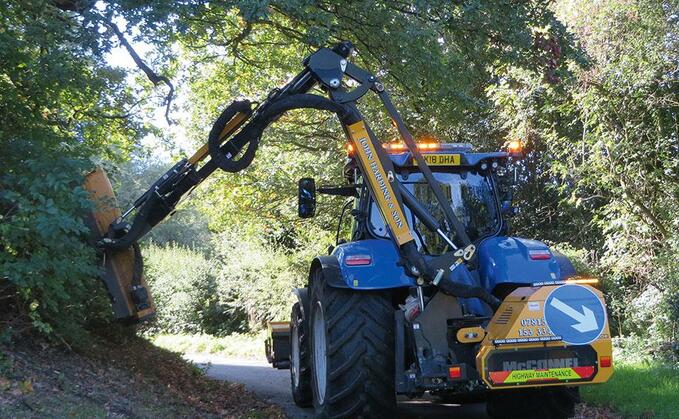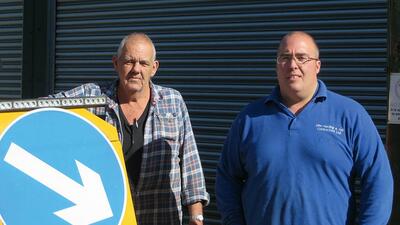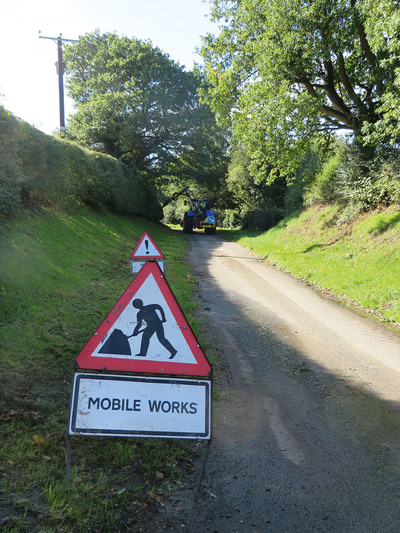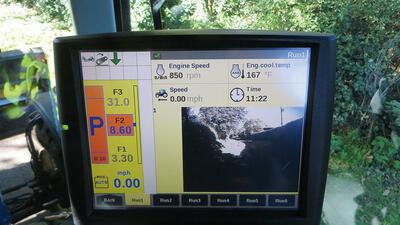
Kit for the job
New Holland T7.235 and McConnel 6585 VFR plus McConnel Magnum front mower
New Holland T7.175 and McConnel 6585 VFRT plus McConnel Magnum front mower
McConnel PA 55 EDS
McConnel PA 32 compact tractor flail
Bomford forestry mulcher
Paul says: "Our contracts stipulate two flashing lights on the tractor, a blue ‘keep right' arrow on the hedgecutter oil tank, highways maintenance chevron sticker and reversing bleeper on the tractor, plus a daily machinery check to avoid breakdowns. But we do a lot more to ensure we can be seen.
Even the size of tractor is significant - being higher up means we can see over hedges and round bends and we are more easily seen by drivers."
John recalls that when the local authority did its own verge mowing, it used MF135s, while the T7 New Hollands in the Harding fleet make significantly more of a visual impact, he says.
Visibility from the cab also dictates the choice of reach arm. Paul says the company has recently switched to McConnel because the latest 85 Series machines have a slimmer main arm than its previous brand, allowing a better view to the rear.
John adds: "We also use a rear-view camera, which can pick up hazards, such as impatient cyclists trying to pass on the inside."
Two of the hedgecutters are variable forward-reach machines, where the arm design allows the cutting head to be placed alongside the cab, giving a clear view of the job and reducing fatigue from constantly looking behind.
Paul says changing practices, both on farms and for amenity work, have shifted the nature of the job.
"Many local authorities have gone from three cuts a year to two, due to reduced budgets. Other contracts stipulate just one complete cut, plus two ‘visibility cuts' where we trim the first metre of vegetation, bends and at junctions."
Where the main cut takes place in June, the long grass and self-set trees and brambles make for a tougher cut.
"This is more of an issue on rural roads, where the traffic is generally less, so cars are not running onto the verges and helping keep vegetation down. The encroaching growth can have a significant effect on visibility," he explains.
He adds some authorities are now having to spray verges to tackle growth into gulleys, which would previously have been reduced by road sweeping, another victim of budget cuts.
John says: "We have just invested in quad bike sprayers to meet this need and taken on extra staff with spray qualifications. But we are still monitoring the operation to decide the best techniques."
Many farms are now coming out of environment schemes which saw two to three year intervals between cuts.
"Some hedges are a mess, overgrown and straggly," says John. "But farmers now realise hedges are actually better when regularly cut - they become more dense and provide an improved habitat for wildlife. Plus, farmers take pride in their land and would rather see a tidy hedge."
He adds that ironically, even where hedges were on reduced cutting schemes, contractors were still called in to cut at junctions and in gateways for safety.
The heavier growth encountered has led to the purchase of more powerful reach arms, with 85hp motors compared the previous 60hp machines.
John Harding and Son carries out litter picking as part of its service, which removes most obstructions, but protruding manholes can damage machines.
Paul reckons to use four sets of 24 flails for each machine per year, at £7 per flail. Rubber flaps have to be kept up to date to prevent debris flying into the road, with blowers fitted to clear hedge clippings.
He says: "We work machinery hard, so it is important to keep it up to date, and we replace reach arms every couple of years, while the tractors last 8,000-9,000 hours.
"There is also a lot of paperwork to complete, especially for local authority contracts, so it is important operators are prepared to do this and take all the necessary safety precautions as well as drive the machinery," he says.


































